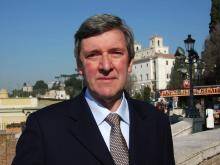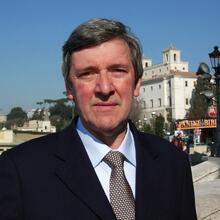Is an accord between the Holy See and China on the horizon? China watchers are asking this question following a flurry of interviews, articles and comments in the Chinese and Italian media in early 2015.
The interest began when Vatican Insider interviewed some Chinese bishops who encouraged the Holy See to reach agreement with China on the appointment of bishops. The interviews provoked mixed reactions.
Next, Cardinal Pietro Parolin, secretary of state, responding to reporters on March 11 about Sino-Vatican relations, confirmed that “contacts are underway” and “there’s the will to dialogue, a dialogue that has its rhythms and times and we hope can bring some result.” He downplayed speculation that an accord is imminent, saying, “There’s nothing new of importance!” He emphasized, “The only way forward is to talk to one another, to find a meeting point, to try to understand each other and find solutions to existing problems.” He expressed his belief that “the dialogue between the Holy See and China could have enormous benefits for world peace.”
Earlier, Federico Lombardi, S.J., director of the Holy See’s press office, was interviewed by Hong Kong’s Phoenix TV (which has close ties to Beijing) for a Chinese language program on Sino-Vatican relations. He confirmed Pope Francis’ high esteem for China and its people, and his willingness to meet President Xi Jinping in Beijing or Rome.
Asked about the Vatican’s relationship with Vietnam, Father Lombardi cited this as a good example of how relations can develop positively through dialogue. He recalled that Vietnam’s top leaders visited the pope and the Holy See has a nonresident representative who visits the church and civil authorities there.
Afterward, Phoenix TV broadcast a 22-minute discussion program with four panelists on March 11, quoting some of Father Lombardi’s comments, and a two-minute news report. Surprisingly, the discussion gave considerable attention to the Vietnamese model for bishops’ appointments as a reference point for a Sino-Vatican solution. Under its accord with Vietnam, the Holy See presents one candidate’s name to Hanoi, which can approve or reject it. If it rejects, the Holy See presents another name, and so on until agreement is reached. The Phoenix TV discussion, however, presented a reverse model, whereby the government presents a candidate’s name to the Holy See. This is significantly different.
Contrary to media reports, Father Lombardi told me that when speaking about Vietnam with Phoenix TV, he made no mention of the appointment of bishops, much less suggest the Vietnam-Holy See accord as a possible model for China; nor did he use the word model. “I was not transmitting a message. I had no mandate to say anything specific about the development of Sino-Vatican relations,” he stated.
A Holy See delegation met its Chinese counterpart in Beijing in June 2014, and a return meeting is to be held in Rome at a date yet to be agreed on. While several issues have to be resolved, everyone recognizes that at the heart of the dialogue is the disputed question of the appointment of bishops and who has the final say. For the Catholic Church, that is the pope’s prerogative.
The nomination of bishops is a pressing pastoral problem for the church in China today, with some 10.5 million members spread over 138 dioceses (the Vatican’s count) or 97 dioceses (Beijing’s figure). (Statistics for 2014 are from the Holy Spirit Study Centre, Hong Kong.)
These dioceses are governed by 59 state-recognized (so-called open) bishops and 42 “underground” bishops. Many are very old. Some 40 dioceses are without a pastor.
If the Holy See and China fail to reach an agreement on bishops’ appointments, this could have serious consequences. China might then decide to appoint bishops independently, without papal approval—say 10 or 15 or more. This would make them illegitimate. There are eight illegitimate bishops in the “open” church community today. If that number were to reach 20 or more, this would become a schismatic church, a Vatican source told me.
That would be tragic for the mainland church. But it would be bad for China too; it would disprove its claim that it respects religious freedom and would affect negatively its international image. Both sides, therefore, have a vested interest in reaching a mutually acceptable, even if not ideal, accord.








